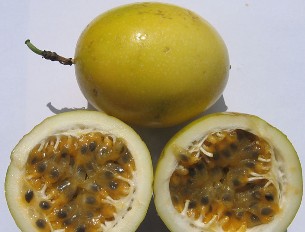Passionfruit
(Passiflora edulis)



Choose passionfruit that is firm with a yellow or purplish tinge in color. It is best to ripen the fruits under controlled conditions. Ripening occurs as the skin becomes wrinkled and soft.
Keep fruits out on racks or shelves being careful not to damage the skin. The flesh can be frozen for longer storage.
Wikimedia


Passionfruit or bell apple grows on climbing vine with variations in skin types. Most passionfruits have hard, green to brown skin that turns yellow to purple, while others have soft, furry yellow skin or even wrinkly skin. The flesh is yellowish-orange in color with black seeds and can be sweet or tart with a rich aroma (Malolo et al., 2001).